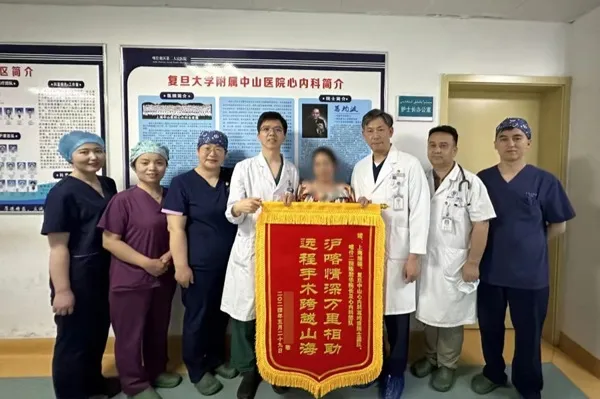Academician Ge Junbo's team realizes "zero-distance" interventional surgery for cardiovascular patients in Shanghai and Kazakhstan, and modern communication with intelligent robots
On May 28, the team of Academician Ge Junbo from Zhongshan Hospital of Fudan University and the Second People's Hospital of Kashgar, Xinjiang successfully implemented the world's longest remote pan-vascular interventional robot-assisted percutaneous coronary intervention surgery across a distance of 5,200 kilometers using 5G technology. . The success of this operation marks an important step in the integration of 5G ultra-telemedicine and vascular interventional robotic technology, becoming an important milestone in the development of the industry.
As an important hub in Eurasia, Kashgar in Xinjiang plays a key role in the construction of the “One Belt, One Road” initiative. Since 2010, Academician Ge Junbo’s team has been working closely with the Second Hospital of Kashgar to share cutting-edge technologies and advanced concepts, and is committed to the in-depth development of high-quality medical resources. Recently, the Kashgar Second Hospital introduced a case in an online consultation: a 53-year-old Uyghur patient who underwent right coronary artery stent implantation for acute inferior wall myocardial infarction a month ago, but was recently readmitted to the hospital due to chest pain. To this end, the Kashgar Second Hospital actively seeks medical assistance through Chen Qingxing, an Xinjiang expert from Zhongshan Hospital, in order to provide patients with more precise and effective treatment plans.
Fortunately, the remote and accurately controlled pan-vascular interventional surgical robot system recently developed by Academician Ge's team and research institutions has completed many drills at the Kashgar Second Hospital. After repeatedly studying the patient's case data, Academician Ge led the team and believed that the patient's condition could be operated on using a remote vascular interventional robot.
Under the coordination of Song Zhenju, Vice President of Zhongshan Hospital Affiliated to Fudan University, Chen Weihua, President of the Second People's Hospital of Kashgar, Xinjiang, and Chen Qingxing, Director of the Department of Cardiology, on the 28th, after sufficient preoperative preparations from both hospitals and approval by the ethics committee, academician Ge Junbo led Chief Physician Shen Li, Deputy Chief Physician Pei Zhiqiang, and Resident Physician Wang Rui worked together with the cardiology team of Kashgar Second Hospital to successfully perform the surgery on the patient.
During the operation, the cardiology team of Kashgar Second Hospital first established femoral artery access for the patient and performed coronary angiography. The results showed that there was 85% severe stenosis in the middle part of the left anterior descending artery, and the stenosis was located at the bifurcation of the blood vessel and close to the myocardial bridge.
In addition, the middle part of the left circumflex artery was almost occluded, the blood vessels were narrow and tortuous, and the lesions were diffuse. Immediately afterwards, Academician Ge remotely controlled the vascular interventional robot in Shanghai, sent the guide catheter to the left coronary artery opening, controlled the main branch guidewire and branch vessel protection guidewire to pass through the stenotic lesion to the distal ends of the anterior descending artery and diagonal branch vessels to establish Orbital, using the micro-speed adjustment function of the interventional robot, cleverly avoiding the myocardial bridge, accurately positioning and releasing a stent. After successfully treating the patient's left anterior descending artery lesion, Academician Ge used a mechanical joystick to remotely and finely adjust the "attack" direction of the guidewire, successfully passing through the subtotal occlusion of the left circumflex artery. Because the blood vessels were relatively small and the lesions were diffuse, Academician Ge used With simple balloon dilation, there is almost no residual stenosis after surgery and avoids the need for stent implantation. Thanks to the close collaboration between the teams from both hospitals, the operation was successfully completed in less than 2 hours. During the operation, Academician Ge Junbo explained every operation detail simultaneously and in detail, imparting valuable experience to the surgical teams from both places.
Ge Junbo said that coronary heart disease is a major health threat in our country, with the number of sick people reaching 11.39 million. In recent years, the mortality rate from coronary heart disease has continued to increase, especially in rural areas. Percutaneous coronary intervention is the main treatment for coronary heart disease, but as the number of patients increases, how to use medical resources more effectively and improve treatment efficiency and quality has become an urgent problem for the medical industry.
The successful implementation of the "zero-distance" cardiovascular interventional surgery in Hukar provided new ideas and solutions to solve this problem. Through the combination of intelligent vascular interventional robots and modern communication technology, more patients with coronary heart disease can enjoy homogeneous high-level medical services by transcending geographical restrictions and integrating technologies and concepts from multiple places.






